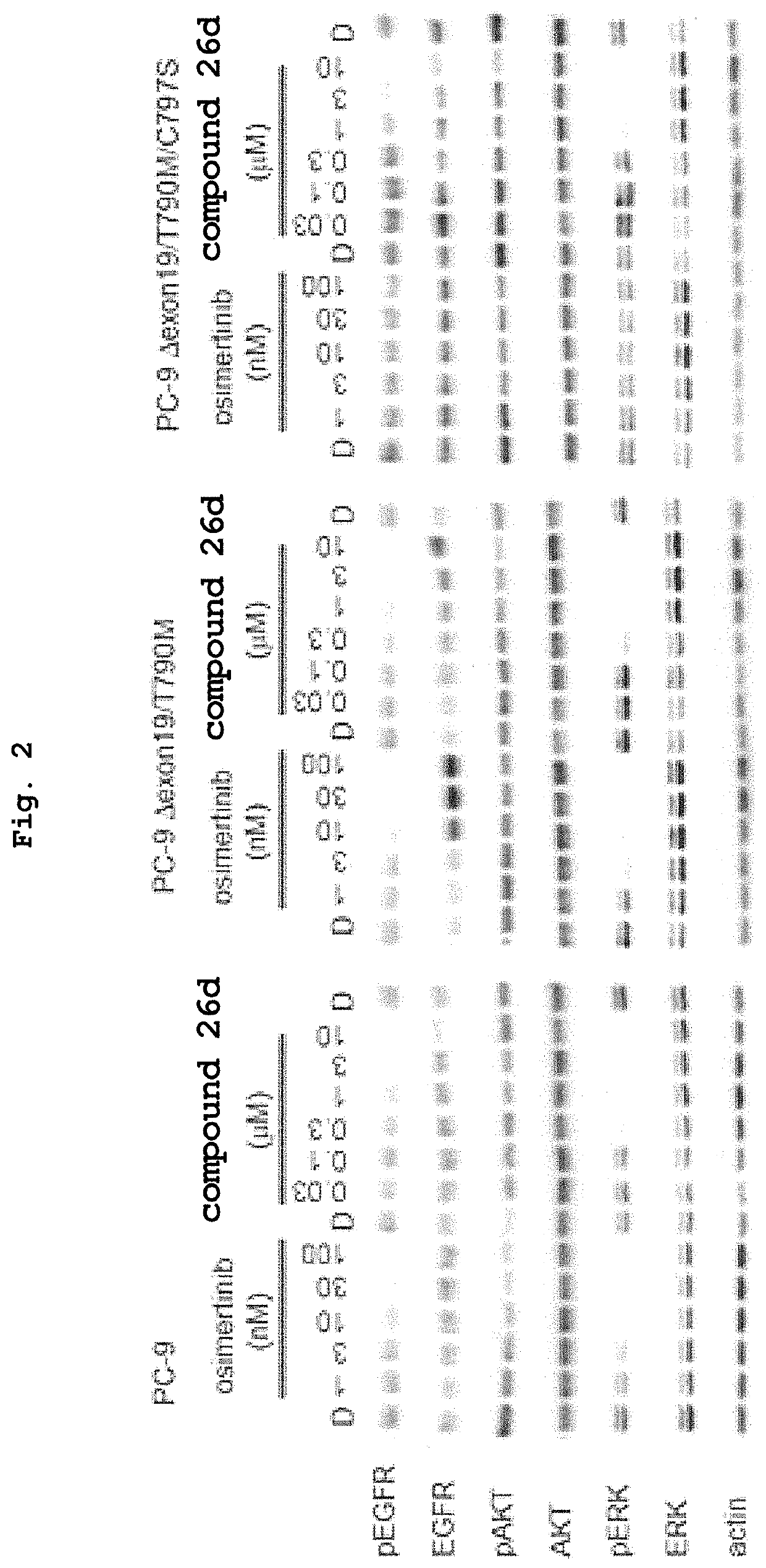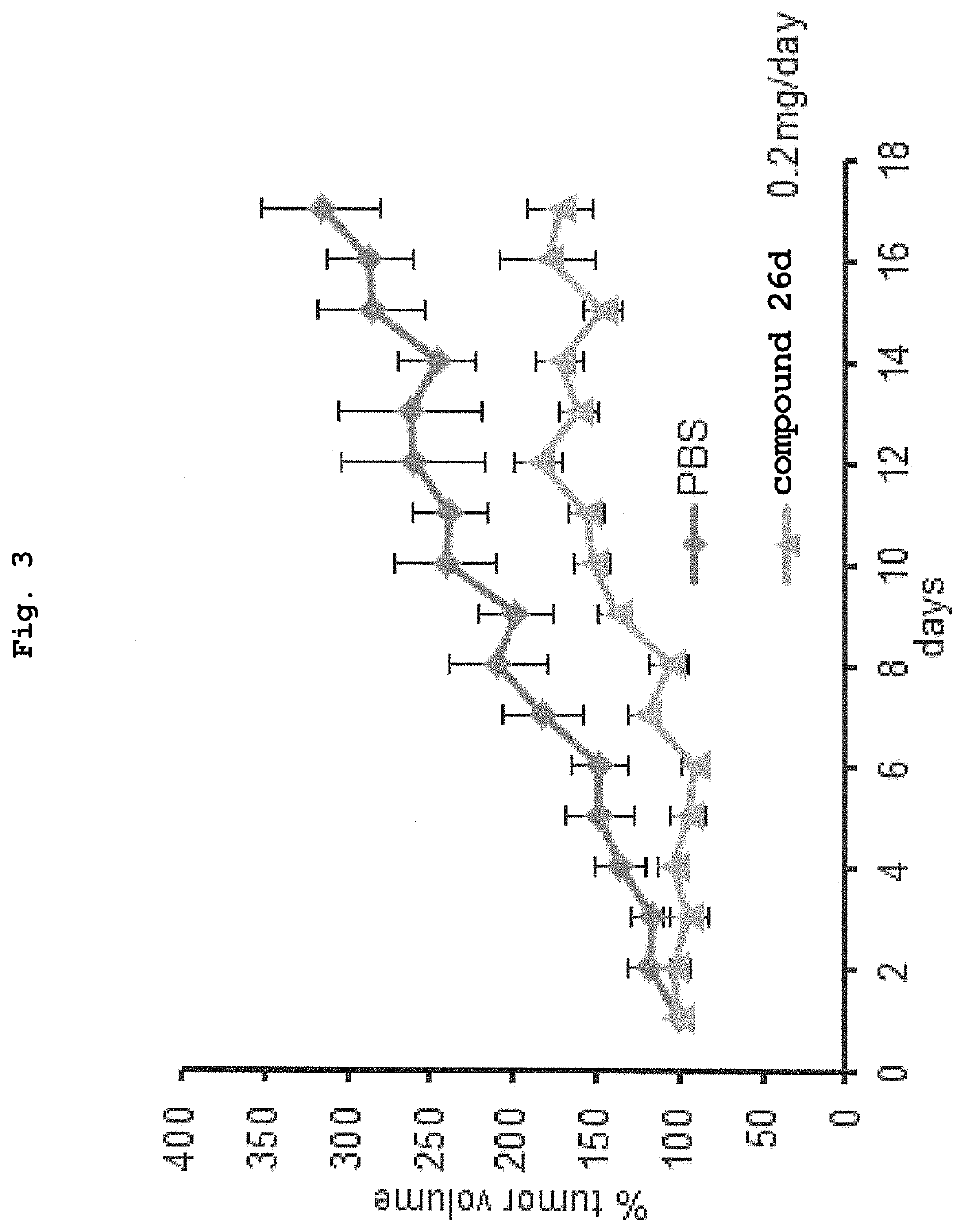Fourth-generation EGFR tyrosine kinase inhibitor
a tyrosine kinase inhibitor, fourth-generation technology, applied in the direction of respiratory disorders, drug compositions, organic chemistry, etc., can solve the problems of insufficient therapeutic effect, insufficient blood concentration of drugs, and cell death
- Summary
- Abstract
- Description
- Claims
- Application Information
AI Technical Summary
Benefits of technology
Problems solved by technology
Method used
Image
Examples
experimental example 1
Evaluation of Proliferation Inhibitory Activity Using EGFR Gene-Transfected BaF3 Cells
[0276]The activity at the enzyme level of a drug is not necessarily directly linked to the activity at the cellular level due to such reasons as the cell membrane permeability of the drug or off-target inhibition. Thus, evaluation of EGFR inhibitory activity using transfected BaF3 cells, which has been established as an evaluation method of kinase inhibitors at a cell level, was performed. BaF3 cells (mouse prolymphocytic cells) can proliferate only in the presence of IL-3 (Interleukin-3). On the other hand, BaF3 cells transfected with EGFR gene can proliferate in an EGFR-dependent manner even in the absence of IL-3. When an EGFR inhibitor is added, BaF3 cells cannot proliferate; however, when IL-3 is added, they can proliferate even in the presence of an EGFR inhibitor. Utilizing such properties, the activity and specificity of an EGFR inhibitor can be evaluated.
[0277]This time, the proliferation ...
experimental example 2
Evaluation of Proliferation Inhibitory Activity of Compound 26d in a Wild-Type EGFR Gene-Transfected BaF3 Cell
[0285]The selectivity of compound 26d for EGFR with an activating mutation was examined using BaF3 cells expressing wild-type EGFR without an activating mutation. 2 μg of pBABE-EGFR wild-type was introduced into BaF3 cells (2×106 cells) by using the NEON electroporation system (Thermo Fisher Scientific, Inc.), and the cells were cultured in RPMI-1640 medium containing 10 ng / mL IL-3, 100 U / mL penicillin, 100 μg / mL streptomycin and 10% fetal bovine serum under 5% carbon dioxide / 95% air atmosphere at 37° C. Two days later, 1 μg / mL puromycin was added and resistant cells were selected. The cells were washed twice with PBS, seeded in a 96 well microplate (Thermo Fisher Scientific, Inc.) at 30000 cells / well, 10 ng / mL EGF or IL-3 and various concentrations of compound 26d were added and the cells were cultured in 150 μL of the medium for 4 days. 15 μL of 5 mg / mL MTT (thiazolyl blue...
experimental example 3
Evaluation of Proliferation Inhibitory Activity Using EGFR Gene-Transfected Lung Adenocarcinoma Cells
[0288]The proliferation inhibitory activity of compound 26d in a lung adenocarcinoma cell line was examined. 2 μg of pBABE-EGFR was transfected into a lung adenocarcinoma cell line, PC-9, with an exon19 deletion (del exon19) in the EGFR gene by using Viafect transfection reagent (Promega KK.) and the cells were cultured in RPMI-1640 medium containing 100 U / mL penicillin, 100 μg / mL streptomycin and 10% fetal bovine serum under 5% carbon dioxide / 95% air atmosphere at 37° C. Two days later, 2 μg / mL puromycin was added and resistant cells were selected. These cells and A549 cells expressing wild-type EGFR were seeded in a 96 well microplate (Thermo Fisher Scientific, Inc.) respectively at 3,000 cells / well and 7,500 cells / well, various concentrations of the test compound were added, and the cells were cultured in 150 μL of the medium for 4 days. 15 μL of 5 mg / mL MTT (thiazolyl blue tetraz...
PUM
| Property | Measurement | Unit |
|---|---|---|
| body weight | aaaaa | aaaaa |
| body weight | aaaaa | aaaaa |
| body weight | aaaaa | aaaaa |
Abstract
Description
Claims
Application Information
 Login to View More
Login to View More - R&D
- Intellectual Property
- Life Sciences
- Materials
- Tech Scout
- Unparalleled Data Quality
- Higher Quality Content
- 60% Fewer Hallucinations
Browse by: Latest US Patents, China's latest patents, Technical Efficacy Thesaurus, Application Domain, Technology Topic, Popular Technical Reports.
© 2025 PatSnap. All rights reserved.Legal|Privacy policy|Modern Slavery Act Transparency Statement|Sitemap|About US| Contact US: help@patsnap.com



